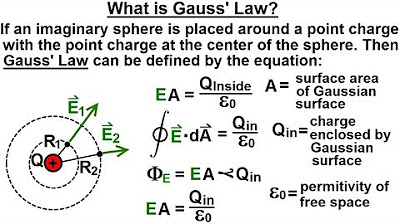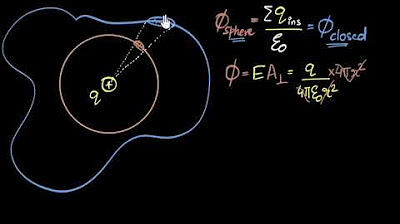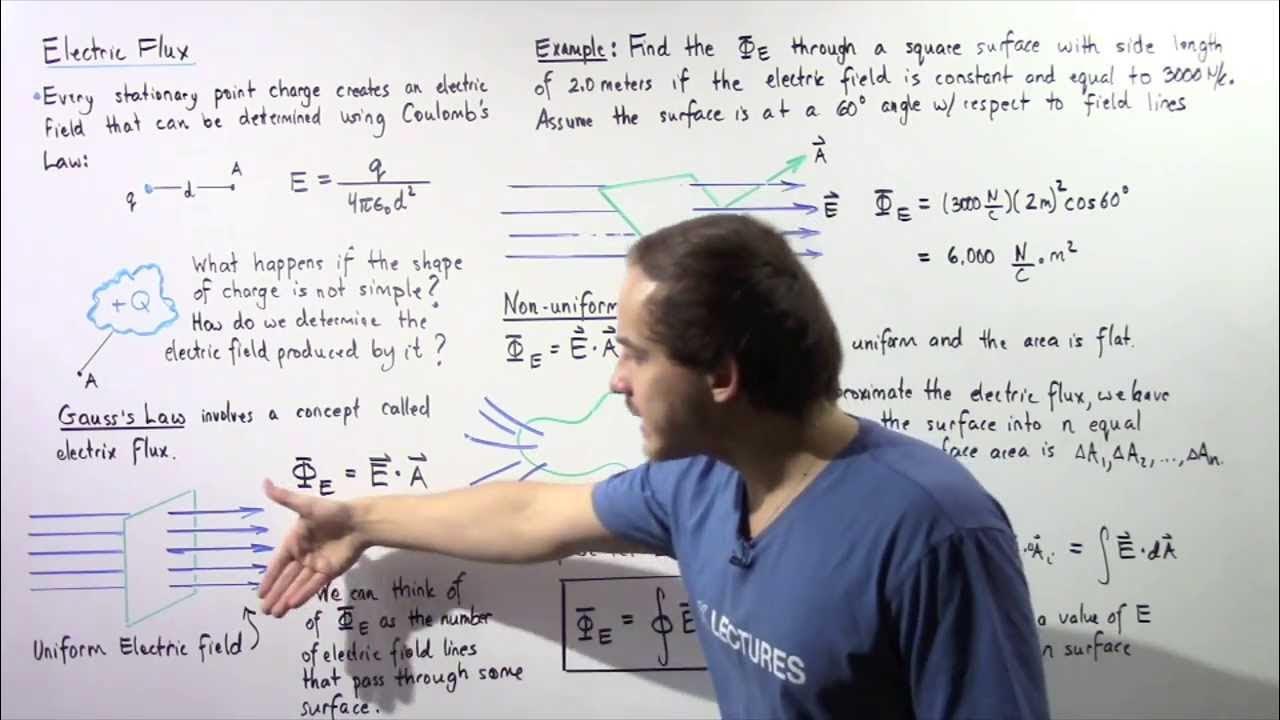Ultimate Gauss' Law review
TLDRThis script offers a comprehensive review of Gauss's law, a fundamental principle in electromagnetism. It explains the concept of electric flux through a closed surface and its relationship with the enclosed charge, divided by the permittivity of free space (epsilon naught). The script covers various scenarios, including point charges, charged metal shells, insulating spheres with uniform or non-uniform charge densities, cylindrical and planar symmetries, and cases requiring integration for non-uniform charge distributions. It simplifies the application of Gauss's law by demonstrating how to calculate electric fields in symmetrical situations and provides a solid foundation for solving problems related to electric fields and charges.
Takeaways
- 📚 Gauss's law is a fundamental principle in electromagnetism stating that the electric flux through a closed surface is equal to the charge enclosed divided by the permittivity of free space (ε₀).
- 🌐 A Gaussian surface is a closed surface used to apply Gauss's law, and its selection is crucial for simplifying the calculation of the electric field.
- 🔋 For a point charge, Gauss's law simplifies to the electric field (E) being proportional to the charge (Q) and inversely proportional to the square of the distance (r) from the charge, represented as E = kQ/r².
- 💠 When a point charge is inside an uncharged metal shell, the electric field inside the shell is zero due to the redistribution of charges within the metal.
- 🏺 If the metal shell is pre-charged, the charge on the inner surface neutralizes the point charge, and the electric field outside the shell is determined by the total charge (shell charge + point charge).
- 🛑 The electric field inside a conductor in electrostatic equilibrium is zero, regardless of any internal or external charges.
- 🔄 For a uniformly charged insulating sphere, the electric field can be found by considering the charge density (ρ) and the volume enclosed by the Gaussian surface.
- 📏 In cylindrical symmetry, the electric field is determined by the line charge density (λ) and the radius of the Gaussian cylinder, with the electric field being uniform and perpendicular to the charge distribution.
- 📈 For non-uniform charge distributions, an integral over the volume is required to find the charge enclosed by a Gaussian surface, using the differential volume element (DV) appropriate for the symmetry.
- 📋 The electric field due to an infinite plane with uniform surface charge density (σ) is constant and does not diminish with distance, resulting in E = σ/(2ε₀).
- 🔍 Gauss's law can be applied to various symmetrical charge distributions, and the key to solving problems is selecting an appropriate Gaussian surface that simplifies the calculation of electric flux.
Q & A
What is Gauss's law and what does it state?
-Gauss's law is a fundamental principle in electromagnetism that states the electric flux through any closed surface is equal to the total charge enclosed by that surface divided by the permittivity of free space, epsilon naught.
What is a Gaussian surface and why is it important in Gauss's law?
-A Gaussian surface is an imaginary closed surface used in the application of Gauss's law. It is important because the electric field that pierces through this surface is integrated to find the electric flux, which is then used to determine the enclosed charge according to Gauss's law.
How does the choice of Gaussian surface simplify the application of Gauss's law?
-Choosing a Gaussian surface with specific symmetries (spherical, cylindrical, or planar) where the electric field is uniform across the surface simplifies the application of Gauss's law. This uniformity allows the electric field to be taken outside of the integral, making the calculation of electric flux straightforward.
What is the significance of the electric field being uniform across a Gaussian surface?
-If the electric field is uniform across a Gaussian surface, it simplifies the integral of the electric field through the surface. The uniform field can be factored out of the integral, resulting in a simpler calculation of the electric flux as the product of the field, the surface area, and the cosine of the angle between the field and the normal to the surface.
What happens to the electric field inside a metal in electrostatic equilibrium?
-In electrostatic equilibrium, the electric field inside a metal is zero. This is because any excess charge resides on the surface of the conductor, and the metal's conductivity ensures that the charges redistribute until the internal field is canceled out.
How does the presence of a charged metal shell affect the electric field outside of it?
-A charged metal shell will induce an equal and opposite charge on its inner surface, effectively creating a zero net charge inside the shell. Outside the shell, the electric field is due to the total charge on the shell, which is the same as if there were no shell present.
What is the electric field due to a point charge enclosed by a spherical Gaussian surface?
-The electric field due to a point charge enclosed by a spherical Gaussian surface is given by E = kQ/r^2, where k is the electric constant, Q is the charge, and r is the radius of the sphere.
How does the presence of an insulating charged sphere with uniform charge density affect the electric field?
-For an insulating charged sphere with uniform charge density, the electric field inside the sphere decreases linearly from the surface to the center, where it is zero. Outside the sphere, the electric field follows the same inverse-square law as a point charge, with the total charge of the sphere as the source.
What is the electric field due to an infinite plane with uniform surface charge density?
-The electric field due to an infinite plane with uniform surface charge density is constant and perpendicular to the plane, given by E = σ/(2ε₀), where σ is the surface charge density and ε₀ is the permittivity of free space.
How can the total charge enclosed by a Gaussian surface be calculated when the charge density is not uniform?
-When the charge density is not uniform, the total charge enclosed by a Gaussian surface is calculated by integrating the product of the charge density and the volume element (dV) over the entire volume enclosed by the surface.
Outlines
📚 Gauss's Law Fundamentals and Application
This paragraph introduces Gauss's law, which equates the electric flux through a closed surface to the charge enclosed divided by the permittivity of free space (epsilon naught). It explains the concept of a Gaussian surface, which is a closed surface used to calculate electric flux, and how to apply Gauss's law when the electric field is uniform over this surface. The summary also covers how to adjust the law for scenarios with spherical, cylindrical, and planar symmetry, and emphasizes the importance of choosing the right Gaussian surface to simplify calculations.
🌐 Point Charges and Metal Shells in Gauss's Law
The second paragraph delves into specific applications of Gauss's law with point charges and metal shells. It explains how to calculate the electric field for a point charge using a spherical Gaussian surface and how the presence of an uncharged or pre-charged metal shell affects the electric field both inside and outside the shell. The discussion highlights the principle that the electric field inside a conductor at electrostatic equilibrium is zero, and how charges redistribute on the surface of a conductor to achieve this state.
🔋 Insulating Charged Spheres and Non-Uniform Charge Distributions
This section discusses the use of Gauss's law for insulating spheres with uniform and non-uniform charge distributions. It explains how to calculate the charge enclosed by a Gaussian surface for different scenarios, such as when the surface is inside, within, or outside the sphere. The paragraph also addresses how to handle situations where the charge density is not uniform, requiring an integral approach to determine the total charge enclosed.
📏 Cylindrical Symmetry in Gauss's Law
The fourth paragraph focuses on applying Gauss's law to cylindrical symmetry, explaining how to calculate the electric field for a line charge and an insulating cylinder with uniform charge density. It covers the process of finding the charge enclosed by a Gaussian cylinder and the adjustments needed when the cylinder has a hole or when the charge density is not uniform, requiring integration.
📏 Planar Symmetry and Infinite Charge Distributions
This paragraph explores planar symmetry, specifically the unique case of an infinite plane with a uniform surface charge density. It explains the constant electric field produced by an infinite plane and how to calculate it using Gauss's law. The discussion also touches on the implications of having an infinite plane, which is a theoretical construct not found in reality but useful for understanding electric field behavior.
🔍 Comprehensive Review of Gauss's Law Examples
The final paragraph serves as a recap of the entire video script, summarizing the various examples and scenarios covered under Gauss's law. It reviews the methods for calculating electric fields and charges for different symmetries and configurations, including the use of integration for non-uniform charge distributions. The summary emphasizes understanding the direction of electric fields and the importance of selecting appropriate Gaussian surfaces for each situation.
Mindmap
Keywords
💡Gauss's Law
💡Electric Flux
💡Gaussian Surface
💡Epsilon Nought (ε₀)
💡Point Charge
💡Electric Field
💡Spherical Symmetry
💡Cylindrical Symmetry
💡Planar Symmetry
💡Charge Density
Highlights
Gauss's law states that the electric flux through any closed surface is equal to the charge inside that surface divided by the permittivity of free space (epsilon naught).
A Gaussian surface must be closed and have a defined inside and outside to integrate the electric field piercing through its area.
Gauss's law is most useful when the electric field can be taken outside the integral by choosing a surface where the field is uniform across the area.
The formula E times A equals Q n over epsilon naught simplifies the application of Gauss's law for finding electric fields.
Symmetry plays a crucial role in simplifying Gauss's law, with spherical, cylindrical, and planar symmetries being the most common.
For a point charge, a spherical Gaussian surface can be used to derive the electric field formula E equals kQ over r squared.
An uncharged metal shell around a point charge will have no electric field inside due to charge polarization.
A charged metal shell will have an electric field outside that is determined by the total charge on the shell.
An insulating charged sphere with uniform charge density can be analyzed using Gauss's law to find the electric field at any point.
If the charge density is not uniform, an integral must be used to calculate the charge enclosed by a Gaussian surface.
Cylindrical symmetry allows for the calculation of electric fields around infinite lines of charge and cylindrical charge distributions.
The electric field around an infinite plane with uniform surface charge density is constant and does not diminish with distance.
The method to find the charge enclosed by a Gaussian surface involves integrating the charge density over the volume for non-uniform charge distributions.
For a sphere with a hole, the charge enclosed by a Gaussian surface is calculated by subtracting the volume of the hole from the total volume.
The electric field due to a non-uniform cylindrical charge distribution is found by integrating the charge density with respect to the volume element.
In planar symmetry, the electric flux through the top and bottom faces of a Gaussian box is used to determine the electric field.
The electric field from an infinite plane is uniform regardless of distance, which is a unique result from Gauss's law.
The video provides a comprehensive review of Gauss's law applications, including various symmetrical charge distributions.
Transcripts
Browse More Related Video

Electric Flux and Gauss’s Law | Electronics Basics #6

Physics 37.1 Gauss's Law Understood (3 of 29) What is Gauss' Law?

Gauss law logical proof (any closed surface) | Electric charges & fields | Physics | Khan Academy

Electric Flux

Electric Flux (part 1)

Electric Flux and Gauss' Law - Review for AP Physics C: Electricity and Magnetism
5.0 / 5 (0 votes)
Thanks for rating: